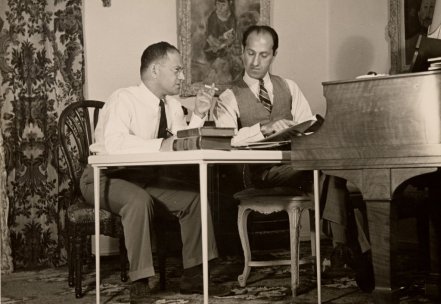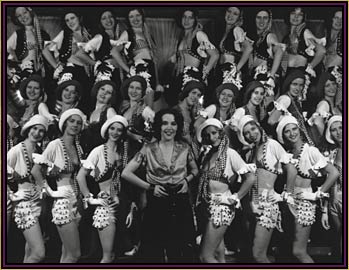
Amazing as their music is, a lot of George and Ira Gershwin’s musicals aren’t presented today in their original forms, and while Girl Crazy is no different, it has stayed more intact than the vast majority of its mates, at least in terms of its music. Girl Crazy marked the debut of such classics as “I Got Rhythm” and “Embraceable You,” both of which have had long and fruitful lives outside of the original show.
Its charm lies in its uncomplicated irony: Playboy Danny Churchill won’t stay away from the ladies so he’s exiled to Custerville, Arizona by his millionaire dad. He’s supposed to manage the family ranch, but he’s such a divo he takes a cab from New York to Arizona. Yeah. The whole way. It costs over seven hundred dollars in 1930s money. Then Danny decides to turn the ranch into an ongoing party, with dancing girls and music galore, and just in case it’s all too placid, he meets Molly, the lovely female postal worker every guy in town pines for. He’s interested, of course. She’s not, of course.

Gershwin had to bring his A-game with this new show, as his previous production, the satirically political Strike Up the Band had been a flop. This time around, Gershwin loaded the show with sure talent, filling the orchestra with the likes of Benny Goodman, Gene Krupa, and Glenn Miller. He also went for the tried-and-true formulas of lots of pretty girls and madcap antics.
Among those stepping on the stage were Allen Kearns as Danny Churchill, a then-nineteen year old Ginger Rogers as Molly Gray and a then-twenty-two year old Ethel Merman as brassy cafe singer Kate Fothergill. Girl Crazy premiered in Philadelphia on September 29, 1930 then in New York on October 14 and ran for 272 performances, with Gershwin conducting the orchestra himself.

Ethel Merman’s entry into Girl Crazy was rather auspicious. According to Merman biographer, Brian Kallow, Merman was first discovered by producer Vinton Freeley, who heard former stenographer Merman singing in a nightclub and was tremendously impressed with her confidence and strength. He waited around until her show was done and then invited Merman to personally audition for the Gershwins at George’s penthouse suite on 33 Riverside Drive.
What happened in the penthouse is the stuff of legend. According to Merman, after playing “I’ve Got Rhythm” and “Boy! What Has Love Done For Me,” George said, “Miss Merman, if there’s anything about these songs that you don’t like, I’d be most happy to change it.”

Merman, gobsmacked, answered that the songs were just fine.
Ginger Rogers’ experience wasn’t too shabby, either. By 1930 she had two hits to her credit: the 1929 stage musical, Top Speed and a film called Young Man Of Manhattan. When she went to audition for Girl Crazy, Gershwin himself accompanied her, and, to Rogers’ delight, he could play in every key. It sounds funny, but great composers are not always competent musicians (Looking at you, Mr. Berlin). Rogers was a shoo-in, probably because she had the brassy westerner act down pat.

The show won rave reviews, especially for Ethel Merman, who brought down the house from her first performance at the Alvin Theatre. Ginger Rogers, well…everyone knows where she ended up.
And we all know where this goes next: As with any hot property, Hollywood wanted in on the action. What a lot of fans of the 1943 film might not be aware of, and I certainly wasn’t until I started researching the show, is that the Judy-Mickey movie was actually the second time Girl Crazy hit the big screen. The first was in 1932 and it was kind of a flop.

The problem was that the movie strayed from what made the stage show successful, which was the light, airy, plot with its generous twist of wryness. Most of the songs were cut as well. Instead, the film featured a comedy team named Burt Wheeler and Robert Woolsey, the latter of whom plays Jimmy, a cab driver who becomes sheriff of Custerville in a below-the-board election. Girl craziness was incidental to the plot.
On the plus side, legend has it one Busby Berkeley was the movie’s uncredited choreographer, but no one knows for sure. According to biographer Jeffrey Spivak, Berkeley wouldn’t talk about his involvement with the film, and Hollywood seemed to want to memory-hole it as soon as it was released, so it’s probably best to let it lie.

Berkeley’s connection to the 1943 version, however, is unquestioned. He infamously directed the boisterous finale, which has cannons firing and cowboys and cowgirls and plenty of tap dancing. It was his only contribution to the movie, as he was fired for pushing Judy Garland too hard, causing her to collapse on set. On doctor’s orders Judy took three weeks off and Norman Taurog took Berkeley’s place.
Changes had to be made to the plot, of course, per the Production Code. Instead of overseeing a bacchanal, Danny Churchill is sent to Cody College, an all-boys school that trains students to mine and ranch. They’re so disciplined they go to bed at nine-thirty every night and get up at six. It’s isn’t all work and no play, though, because on Saturday nights they have movies. “Sometimes talkies,” Danny’s roommate Bud (Gil Stratton) tells Danny.

Danny waffles between quitting and staying, especially when he meets Ginger Gray (Judy Garland), the granddaughter of the dean, Phineas Armour (Guy Kibbee). What cements things is when Ginger breaks up with her boyfriend and Danny finds out the school’s going to close because no one wants to enroll.
With Taurog in charge, the movie was able to show the Gershwin songs to their best advantage. There are a lot of moments when Judy sings out in the desert, such “Bidin’ My Time” at the boys’ overnight campout, when it’s just her, the boys, and a floating guitar. It’s fun in a simple way

Speaking of fun, Girl Crazy was the next-to-last film Judy Garland and Mickey Rooney made together, and even though they’re supposed to be at loggerheads, the good time they were having was evident. Mickey’s schtick gave Judy the giggles, but she held her own as well. When they were getting ready to shoot the big “I’ve Got Rhythm” finale, Mickey told Judy she looked like a vanilla ice cream cone in her white cowgirl outfit. Judy retorted that Mickey looked like a rationed bottle of ketchup.
Audiences loved the film this time around, although Variety noted that a lot of the original bite and adult humor was missing. Judy and Mickey both put in great performances, though, made all the more remarkable by how young they still were at the time. It was a more sophisticated film for both of them in that the music was meatier and the story more integrated beyond just putting on a show.

Girl Crazy always seems to find new life somewhere. Its latest incarnation, the Broadway hit, Crazy For You, is probably not going to be its last, just because it’s hard to go wrong with Gershwin and the battle of the sexes.
Got an announcement dropping on Friday. Thanks for reading, all, and I hope to see you then…
Girl Crazy is available on DVD and Blu-ray from Amazon.
~Purchases made via Amazon Affiliate links found on this site help support Taking Up Room at no extra cost to you.~
Bibliography
Fricke, John. Judy Garland: A Portrait In Art and Anecdote. Boston, New York, London: Bulfinch Press, 2003
Kellow, Brian. Ethel Merman: A Life. New York: Penguin Books, 2007.
Pollack, Howard. George Gershwin: His Life and Work. Berkeley, California: University of California Press, 2007.
Spivak, Jeffrey. Buzz: The Life and Art of Busby Berkeley. Lexington: University Press of Kentucky, 2011.

Very informative post! I learned a lot! Although not my favorite Garland-Rooney movie, it’s fun nevertheless.
LikeLiked by 2 people
It is! Thanks so much, Eric–glad you enjoyed it. 🙂
LikeLiked by 2 people